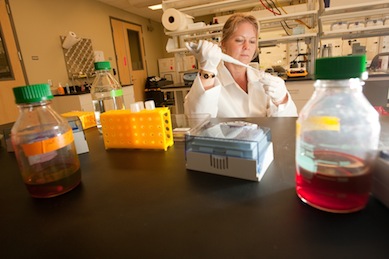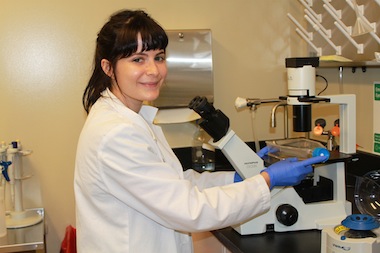Best known for its association with the BRCA gene mutations, triple-negative breast cancer (TNBC) is the only type of breast cancer for which there has yet to be a specific therapy. This type of cancer generally occurs in younger women, is highly metastatic and has a very poor prognosis. Researchers at the University of Houston (UH) are taking on TNBC, hoping their work will lead to new therapies for this devastating disease. 
Working with the protein Maternal Embryonic Leucine-Zipper Kinase (MELK), which has been found to play a role in cancer, the UH research team is working to inactivate MELK in breast cancer cells in order to observe the effects it has on TNBC cells. By identifying changed functions and affected proteins, they recently have come to some conclusions about how MELK affects cells.
“It’s been shown that MELK is in its highest concentrations during cell division,” said UH biology senior Marisa Simon, who received an undergraduate research fellowship this summer to work on this project. “My hypothesis is that MELK safeguards cellular division by blocking the possibility of cell death. This blocking of cell death also can contribute to the longevity of cells. This gives researchers a potential target for cancer therapy. If MELK is essential to the division of cancer cells, then inhibiting it could inhibit and decrease tumor formation. Knowing what is affected by inactivating MELK will help researchers identify not only whether inhibiting it is effective, but also if it is safe.”
Collaborating with graduate student Fahmi Mesmar and led by assistant professor Cecilia Williams in UH’s Center for Nuclear Receptors and Cell Signaling (CNRCS), Simon says they have defined which other proteins and pathways MELK affects in TNBC cells, many of which relate to the death of cells and the cell cycle. The team is currently working on confirming these findings.
“Marisa has collected impressive amounts of interesting data,” Williams said. “The microarray analysis she performed, whereby she analyzed the effect MELK has on every single gene in our genome’s approximately 23,000 genes, has given us data for the impact of MELK on a global genome level. We are now working to decipher its impact to get a wide and complete understanding of what MELK does in TNBC cells, as well as how we can best use MELK to design better treatments.”
Found in both men and women, the MELK protein also may play a role in other cancers, such as prostate cancer. The researchers say MELK concentrations are high in stem cells and appear to protect them from dying. If MELK turns out to be a desirable target for cancer treatment, then inactivating it could be less hazardous to patients than conventional chemotherapy and radiation, which have pervasive effects on the body since they not only target cancer cells, but also other cells within the range of treatment. Since MELK inhibition would only be targeting the growth of stem cells, it would decrease these negative impacts. 
Williams says this research was initiated several years back in her lab, and research leading up to it has been published in the scientific journals Breast Cancer Research and Carcinogenesis. Her lab also has several other projects that relate to designing better treatments for breast cancer, including achieving a better understanding of how estrogen affects the development and growth of breast cancer and how certain microRNAs affect metastasis of breast cancer. These studies are connected to a large NIH-funded project the lab is doing on colon cancer, where estrogen and microRNAs also play a role and may be used to create better preventative treatments.
“Marisa has been a very good addition to my lab. She is full of enthusiasm, eager to do the work and has contributed to the direction of the project,” Williams said. “Her work is extremely relevant to my research of how poor-prognosis breast cancer functions, so that we can better understand how to target this type of cancer in the future.”
With her funding being extended to cover her senior honors thesis, Simon recently presented the research on MELK’s role in TNBC at UH’s annual Undergraduate Research Day in October. One of UH’s most prolific cancer researchers, Williams’ breast cancer research is funded, in part, by a grant to the CNRCS from the Texas Emerging Technology Fund.
###
About the University of Houston
The University of Houston is a Carnegie-designated Tier One public research university recognized by The Princeton Review as one of the nation’s best colleges for undergraduate education. UH serves the globally competitive Houston and Gulf Coast Region by providing world-class faculty, experiential learning and strategic industry partnerships. Located in the nation’s fourth-largest city, UH serves more than 39,500 students in the most ethnically and culturally diverse region in the country. For more information about UH, visit the university’s newsroom.
About the College of Natural Sciences and Mathematics
The UH College of Natural Sciences and Mathematics, with 193 ranked faculty and nearly 6,000 students, offers bachelor’s, master’s and doctoral degrees in the natural sciences, computational sciences and mathematics. Faculty members in the departments of biology and biochemistry, chemistry, computer science, earth and atmospheric sciences, mathematics and physics conduct internationally recognized research in collaboration with industry, Texas Medical Center institutions, NASA and others worldwide.
About the UH Center for Nuclear Receptors and Cell Signaling
Established in 2009, UH’s Center for Nuclear Receptors and Cell Signaling (CNRCS) is a leading component of the UH Health initiative. Led by Jan-Åke Gustafsson, a National Academy of Sciences member and world-renowned expert in the field of nuclear receptors, CNRCS researchers are involved in many aspects of nuclear receptor research, all focused on understanding the roles of these receptors in health and disease. CNRCS researchers are working toward the goal of finding new treatments for an array of significant diseases including cancer, diabetes, metabolic syndrome and neurological disorders. Working from the center’s world-class labs, the researchers combine interdisciplinary research and dynamic collaboration with the Texas Medical Center and industry partners.
To receive UH science news via email, sign up for UH-SciNews.
For additional news alerts about UH, follow us on Facebook and Twitter.